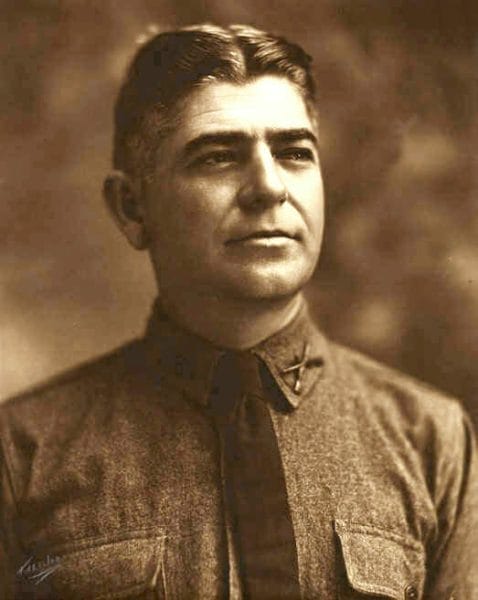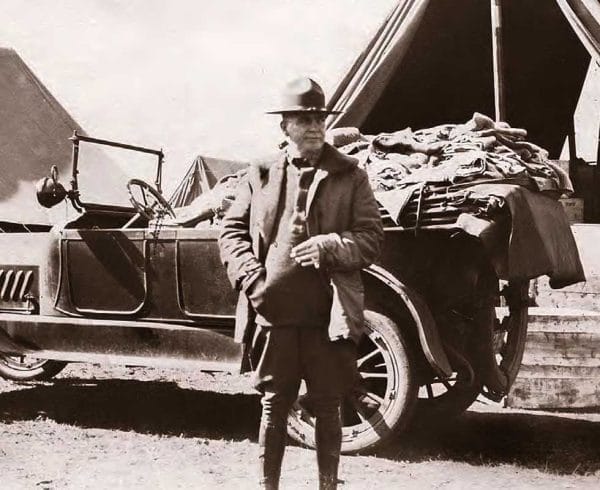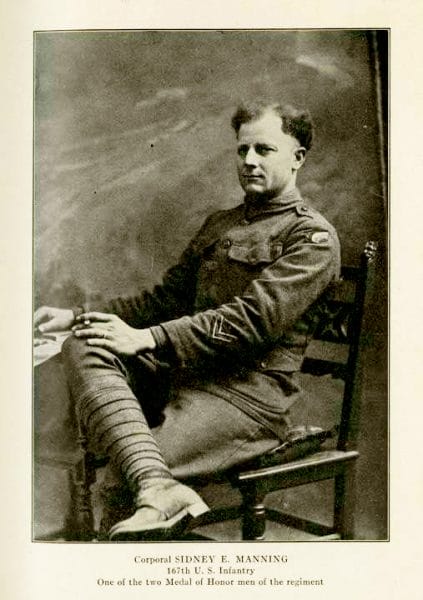William P. Screws
William Preston Screws (1875-1955) enjoyed a distinguished military career in the early twentieth century, including service in the Spanish-American War, the Mexican Border Service, and most notably as commander of the 167th Infantry Regiment in World War I. He retired from active service in 1930 as a full colonel (although he received a late promotion to brigadier general in 1940), after which he became active in Montgomery politics.
 William P. Screws
Born in Montgomery, Montgomery County, to Henry Preston and Ella Nora (Canty) Screws on January 1, 1875, Screws attended Stark Military Academy in Montgomery and then Marion Military Institute in Marion, Perry County. He clerked for Western Railway in Montgomery until the outbreak of the Spanish-American War prompted him, at age 23, to volunteer for service in the 3rd Alabama Volunteers state infantry; he was appointed first lieutenant. From 1899 to 1901, with the 29th U.S. Volunteers, he served in the Philippine-American War on the Philippine island of Luzon, as part of the force that subdued an insurrection in the islands after they were ceded to the United States by Spain. He briefly returned to Montgomery in 1901, during which time he married Josephine Lahey; the couple would have one child. He entered the U.S. Army in October 1901 as a second lieutenant and in this capacity continued his service in the Philippines. He participated in the October 1905 Moro Campaign and Expedition in search of Dato (Datu) Ali, a military and tribal leader from the island of Mindinao.
William P. Screws
Born in Montgomery, Montgomery County, to Henry Preston and Ella Nora (Canty) Screws on January 1, 1875, Screws attended Stark Military Academy in Montgomery and then Marion Military Institute in Marion, Perry County. He clerked for Western Railway in Montgomery until the outbreak of the Spanish-American War prompted him, at age 23, to volunteer for service in the 3rd Alabama Volunteers state infantry; he was appointed first lieutenant. From 1899 to 1901, with the 29th U.S. Volunteers, he served in the Philippine-American War on the Philippine island of Luzon, as part of the force that subdued an insurrection in the islands after they were ceded to the United States by Spain. He briefly returned to Montgomery in 1901, during which time he married Josephine Lahey; the couple would have one child. He entered the U.S. Army in October 1901 as a second lieutenant and in this capacity continued his service in the Philippines. He participated in the October 1905 Moro Campaign and Expedition in search of Dato (Datu) Ali, a military and tribal leader from the island of Mindinao.
At the end of the Philippine-American conflict, Screws was stationed in the Philippine Islands. His son, James, spent his early childhood there, and Screws maintained a life-long interest in and appreciation for the islands, which gained independence as a commonwealth in 1935 and nationhood in 1946.
 William P. Screws
In 1913, the Army appointed Screws inspector and instructor and stationed him back in his home state with the Alabama National Guard. In 1916, Screws was promoted to captain in the U.S. Army and lieutenant colonel in the Alabama National Guard when he took command of the 4th Alabama Infantry Regiment. Screws commanded the 4th Alabama during 1916-17 in the Mexican Border Service, when the federal government sent National Guard units from around the country to help guard the southern U.S. border from incursions by Mexican revolutionaries led by Francisco “Pancho” Villa. In March 1917, Screws and the 4th Alabama returned to Montgomery and, after the U.S. entered World War I in April, began preparing for overseas duty. In August 1917, the 4th Alabama became the 167th Infantry Regiment, part of the 42nd Rainbow Division. Screws received promotion to colonel and served as commander of the 167th until 1919, when the regiment was mustered out of service.
William P. Screws
In 1913, the Army appointed Screws inspector and instructor and stationed him back in his home state with the Alabama National Guard. In 1916, Screws was promoted to captain in the U.S. Army and lieutenant colonel in the Alabama National Guard when he took command of the 4th Alabama Infantry Regiment. Screws commanded the 4th Alabama during 1916-17 in the Mexican Border Service, when the federal government sent National Guard units from around the country to help guard the southern U.S. border from incursions by Mexican revolutionaries led by Francisco “Pancho” Villa. In March 1917, Screws and the 4th Alabama returned to Montgomery and, after the U.S. entered World War I in April, began preparing for overseas duty. In August 1917, the 4th Alabama became the 167th Infantry Regiment, part of the 42nd Rainbow Division. Screws received promotion to colonel and served as commander of the 167th until 1919, when the regiment was mustered out of service.
From Montgomery’s Camp Sheridan to Camp Mills in New York, Screws led the 167th in preparations for trench warfare against the Central Powers (primarily Germany) in France. Once there, Screws attended training sessions and then passed along this new information to his men to ensure that they were as prepared as possible for the coming battles. Known for his high expectations of military discipline among his troops and for his organizational skills, Screws was well respected and admired by his men.
 Sidney Manning
As part of the 42nd Division, the 167th participated in eight battles from February to November 1918. The 167th established a record with 110 days of unrelieved service on the front lines. Under Screws’ command, the regiment received special accolades for capturing key German-held positions at both La Croix Rouge and La Croix Blanche farms. One soldier under Screws’ command, Sidney Manning, later earned the Medal of Honor for his bravery in an assault on German-held Sergy. After the armistice in November 1918, the 167th remained in Europe until the next spring as part of the occupation force. In recognition of his leadership, Screws was awarded the Distinguished Service Medal by Gen. John J. Pershing, commander of U.S. forces on the Western Front, and received the French Legion of Honor with rank of commander.
Sidney Manning
As part of the 42nd Division, the 167th participated in eight battles from February to November 1918. The 167th established a record with 110 days of unrelieved service on the front lines. Under Screws’ command, the regiment received special accolades for capturing key German-held positions at both La Croix Rouge and La Croix Blanche farms. One soldier under Screws’ command, Sidney Manning, later earned the Medal of Honor for his bravery in an assault on German-held Sergy. After the armistice in November 1918, the 167th remained in Europe until the next spring as part of the occupation force. In recognition of his leadership, Screws was awarded the Distinguished Service Medal by Gen. John J. Pershing, commander of U.S. forces on the Western Front, and received the French Legion of Honor with rank of commander.
By May 1919, Screws and his regiment were back in the United States. He led the troops on a welcome-home tour of several cities across Alabama, culminating in an elaborate ceremony and parade in Montgomery. Screws and his men then travelled to Camp Shelby, near Hattiesburg, Mississippi, where the Alabamians were mustered out of federal service. (Screws would remain in touch with some of his men from the 167th, including Montgomery neighbor Everett Jackson.) Screws returned to his prewar Army position as an inspector and instructor for the Alabama National Guard, serving until 1926.
From 1923 to 1924, now at the rank of major, Screws commanded the 67th Infantry Brigade and in 1929 became a senior instructor. He retired at the end of 1930 and was given an honorary promotion to brigadier general in the National Guard in 1940, in recognition of his World War I service. Screws soon became involved in local Montgomery politics, serving as Commissioner of Public Affairs for four terms (1931-47) and on the city’s Civil Defense board during World War II until 1949, and he chaired the State Liquor Control Board upon his appointment by Gov. James “Big Jim” Folsom in the 1940s.
His wife Josephine died in 1937, and Screws never remarried. He did remain active with his family (including his grandchildren who lived next door) and on the Montgomery social scene, playing dominoes at the Beauvoir Club (now the Montgomery Country Club) and attending concerts and the theater. Screws died at the age of 80, on October 26, 1955, of a heart attack, wearing a tuxedo in preparation for attendance at a concert. He was buried in Montgomery’s Greenwood Cemetery.
Further Reading
- Amerine, William H. Alabama’s Own in France. New York: Eaton & Gettinger, 1919.
- Frazer, Nimrod Thompson. Send the Alabamians: World War I Fighters in the Rainbow Division. Tuscaloosa: University of Alabama Press, 2014.
- Truss, Ruth Smith. “The Alabama National Guard’s 167th Infantry Regiment in World War I.” Alabama Review 56 (January 2003): 3-34.
- ———. “Progress Toward Professionalism: The Alabama National Guard on the Mexican Border, 1916-1917.” Military History of the West Champaign, Ill.: Sports Publishing, 2004.
- ———. “The Alabama National Guard at Home and Abroad, 1914-1919.” In The Great War in the Heart of Dixie: Alabama in World War I, edited by Martin T. Olliff. Tuscaloosa: University of Alabama Press, 2008.



